Sweden faced Spain looking to maintain their unbeaten run against the two-time winners of the European Championship on home turf, though Spain arrived knowing that a draw would be enough to secure them a spot in the competition next summer.
Marcus Berg provided the shock opening goal in favour of the hosts, bundling the ball over the line early on in the second half after Spain had dominated the first period. It wasn’t until injury time when Spain got their much needed equaliser, with Rodrigo Moreno coming off the bench despite an injury scare in training, going on to score the late goal.
This tie leaves Spain having gone through from the Euro 2020 qualifiers and Moreno will already be planning his tactics ahead of the competition next summer. This tactical analysis will consider how Sweden fought back from an unconvincing start in order to take the lead and end the game as unfortunate not to take the three points. The analysis explains this notion as Spain proved to have luck on their side in the final stages.
Line-ups
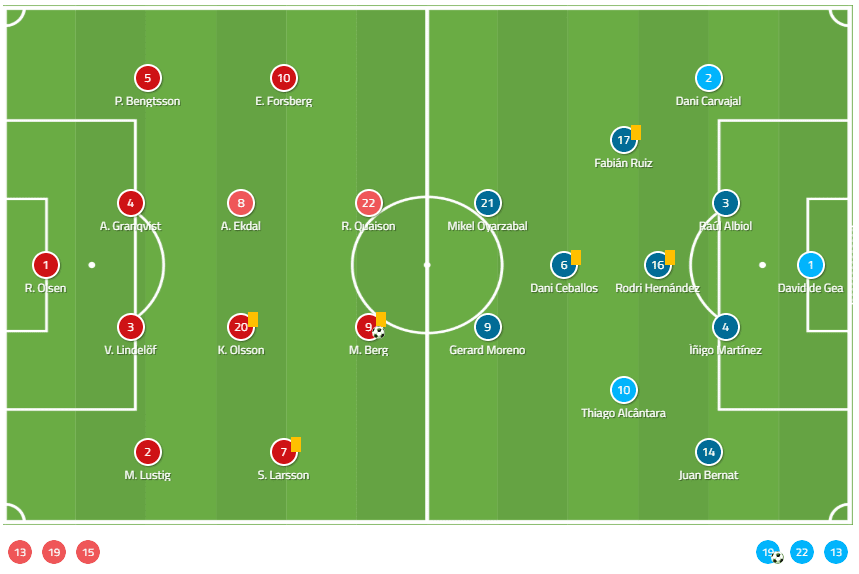
Janne Andersson made just one change for Spain, bringing Victor Lindelof into the side in place of Marcus Danielsson, sticking to the 4-4-2 shape that has served them well in their qualifying campaign so far despite coming unstuck at the Estadio Santiago Bernabéu in June.
For the first time since 2001, Spain lined up without any of their players from the Euro 2008, World Cup 2010 or Euro 2012 victories. There were sweeping changes throughout from Moreno, including in attack where Gerard Moreno was given his debut for his country in the most intriguing team selection decision of the evening. David de Gea also replaced Kepa Arrizabalaga in goal in another notable decision.
Spain’s overcommitment to the press
From the off, Spain started with energy and a high press which suffocated the Swedish side. Led by the front men who pressed high, including when goalkeeper Robin Olsen was in possession, the midfield and full-backs would also provide support. When in the attacking phase and possession was quickly turned over, even pivote Rodri would engage in the press, as is evident in the example here. This worked to begin with, with Sweden struggling to find a way out of their own third and unable to gain control over possession, but quickly faded as they identified the vulnerabilities in the press.
Without much width in midfield, particularly with Mikel Oyarzabal operating most frequently as a second striker, when so many players focused on a central press, it left substantial gaps on the flanks. This allowed the likes of Seb Larsson and Emil Forsberg to exploit these spaces, looking to capitalise on the over-adventurous full-backs who frequently bombed forward and left gaps in behind which provided a real weakness to the Spain set-up. In this example shown below, Oyarzabal joins all four midfielders in a single press, while Dani Carvajal is the guilty party on the right flank which allows Forsberg in.
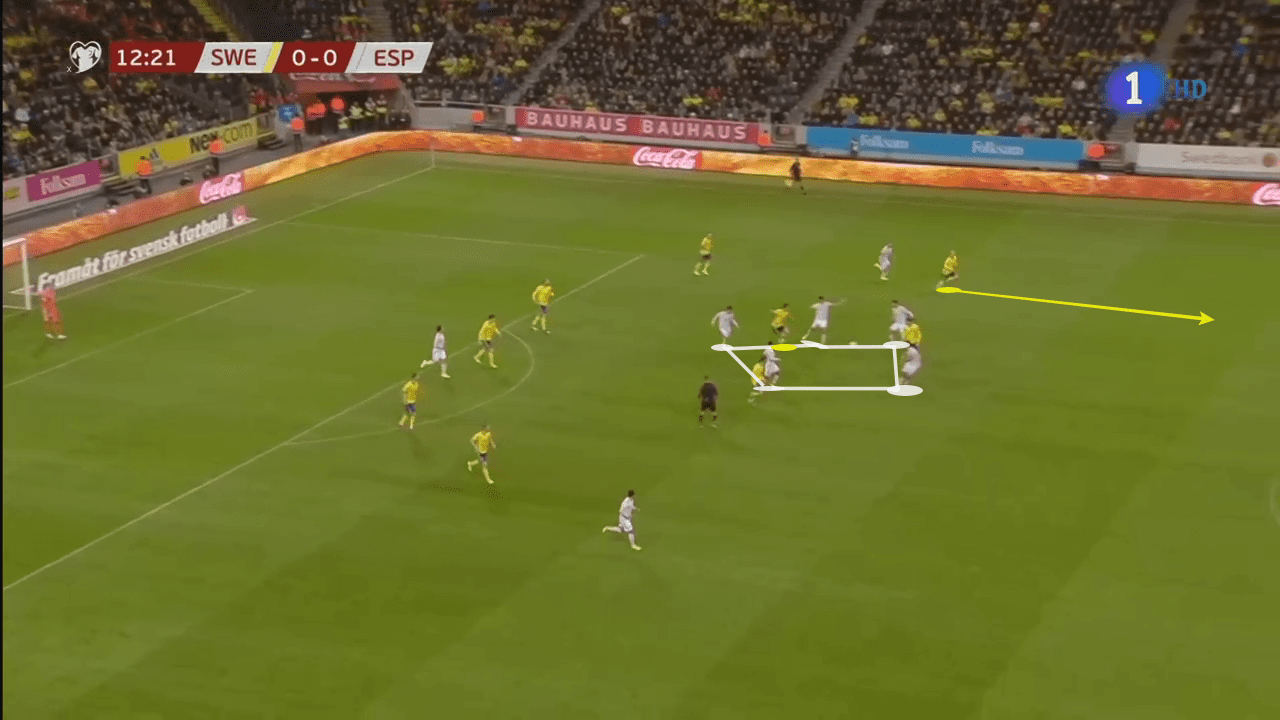
From this moment on, Sweden looked to exploit this weakness to provide them with opportunities on the counter. The pace down the flank of Forsberg in particular was crucial, as Sweden would regain possession, distribute the ball centrally and then immediately look to spread it wide to these spaces once the press had been drawn in. With just 25% of possession and almost a third of the passes that Spain made, 249 compared to 736, this allowed Sweden to pose a consistent threat despite the fact that they had little of the ball by being clinical on the counter against Spain’s press.
Sweden’s refusal to sit deep
Sweden were also admirable in their structure and bravery. Andersson has consistently stuck with the 4-4-2 shape throughout the qualifying campaign and that was again evident against Spain. Even after taking the lead and as they sought to see out the result, later on, Andersson and his team stuck with the 4-4-2 shape throughout. This frustrated a Spain side who are more used to sides sitting deep in numbers and inviting pressure. It meant that Spain were forced to look to the flanks to find a way around the Swedish set-up, which is a narrow one if highly structured.
The introduction of Jesús Navas in the closing stages, replacing Dani Carvajal, proved to be a turning point for Spain as they attempted to break down the Swedish system. He provided more of a natural wing-back which, while it did not alter the formation or shape of Spain’s tactics, it provided a far more offensive option on the flank. As can be seen here, Navas positioned himself far wider and more advanced than Juan Bernat on the opposite flank, looking to use his pace against tired Swedish legs to get at the defence and create space, pulling full-backs wider and creating space in between for midfielders and forwards to run into.
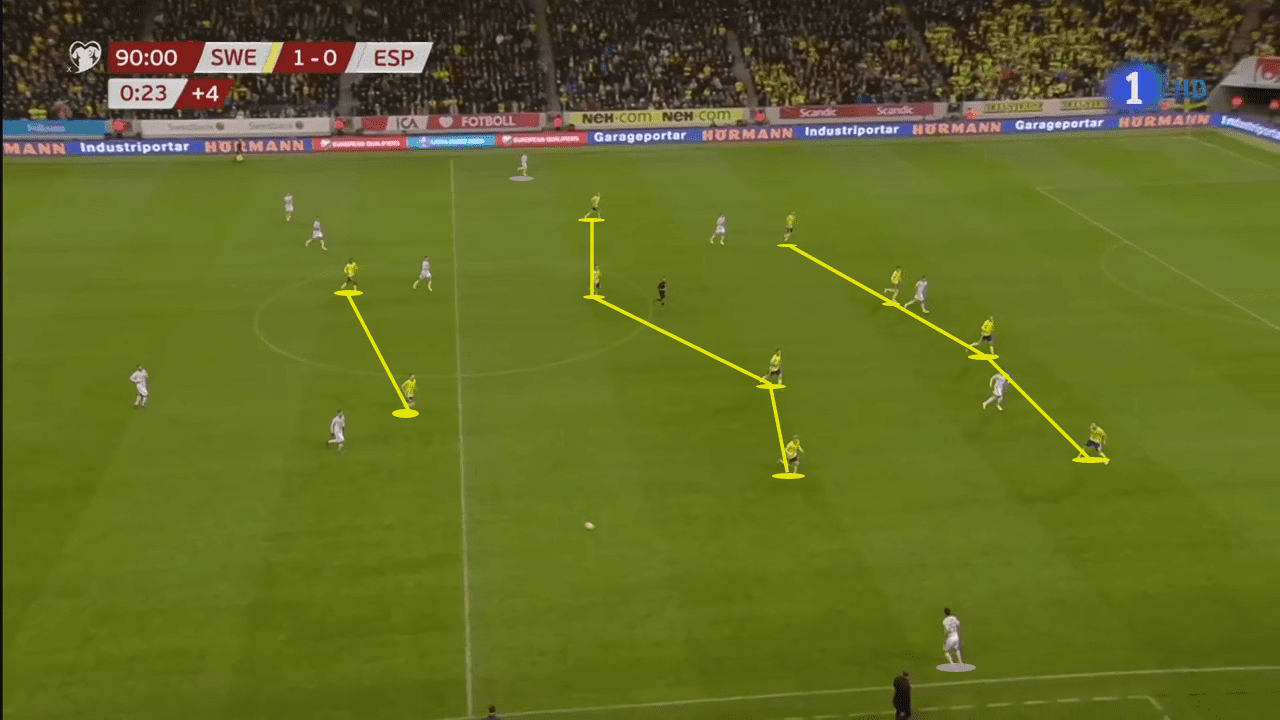
Despite that introduction, Spain were still ineffective in position. Sweden’s positioning and refusal to take a deep defensive line allowed them to maintain possession in a deeper position for Spain. That was reflected in the territorial positioning, where despite dominating possession and having far more of the ball, Spain did not venture into the final third with anywhere near the regularity that would be expected, registering only three more attempts on goal than their Swedish counterparts.
Lack of movement in Spain’s attack
Even when Spain did bring the ball forwards and move it into the final third, they found that there was little impact. This was primarily down to the poor movement from Spain’s frontline. As can be seen in this example late on in the game, Spain’s forwards were positioned close together and were unable to escape the attention of Swedish defenders, none of them getting away from their man.
This meant that as the likes of Navas burst down the flanks, they would be forced to cut inside and look for alternatives rather than being able to bomb forward and put crosses into the box. Even then, the lack of movement in the middle of the park was poor. Frequently, Navas or other players would be forced to play a pass cross-field to Bernat or backwards, passing across the backline and wasting valuable time with possession which made no impact.
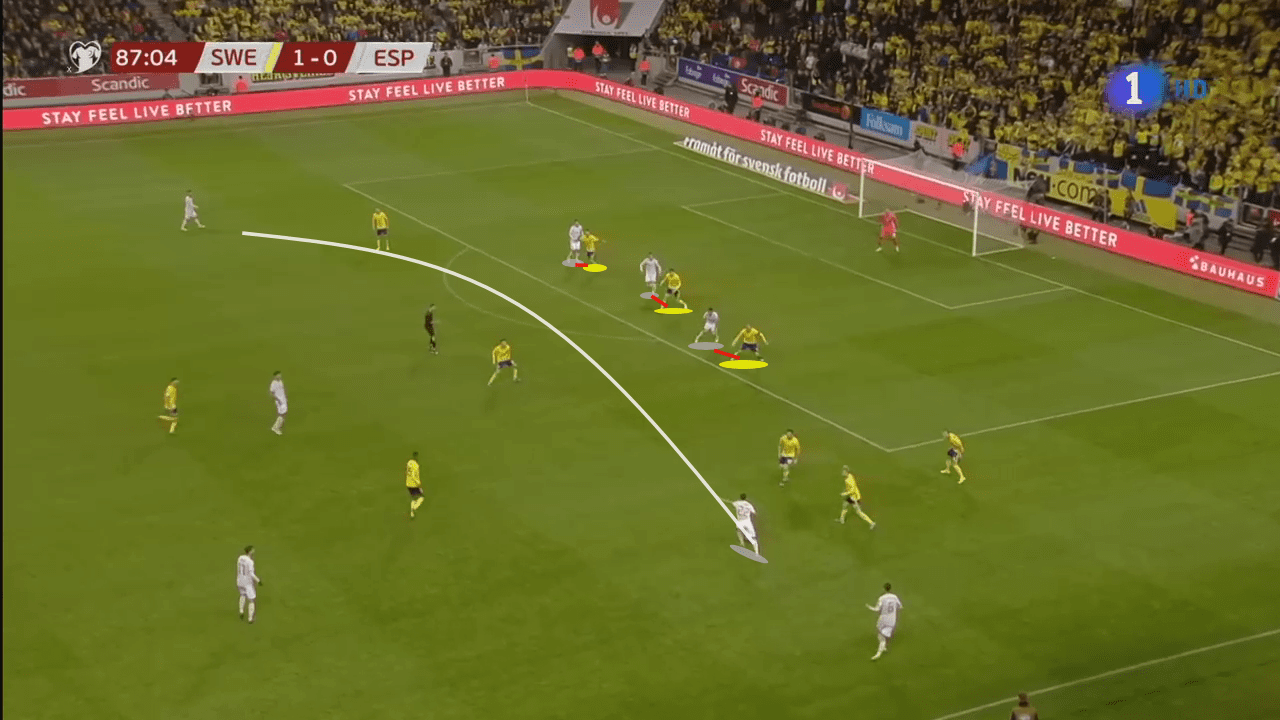
When combined with Sweden’s structure, this meant that it was almost impossible for Spain to create any chances from open play in the final period of the game. In fact, the only clear cut goalscoring opportunity from the final 15 minutes of the match came as Rodrigo converted from a clumsy and chaotic set-piece. This will be a concern for Spain coach Robert Moreno, who selected Villarreal’s Gerard Moreno as his striker but will have been frustrated by the way in which he led the line, acting more as a poacher than as an option to provide movement and create space in attack.
Conclusion
Spain have reverted to many of the challenges that they encountered in the 2018 World Cup in Russia. Whilst they have no problem in dominating possession and the ball, they fail to turn this into a major threat, primarily due to their lack of creativity in attack. Up against a Swedish side which was well organised and well drilled in their game plan, it was no surprise to see Andersson’s men execute their game plan perfectly to take a point. Moreno has plenty of work to do with his Spain side, starting with deciding on his first-choice team and then ensuring that they gain game time together to get the very best out of them just as Andersson has with his side.
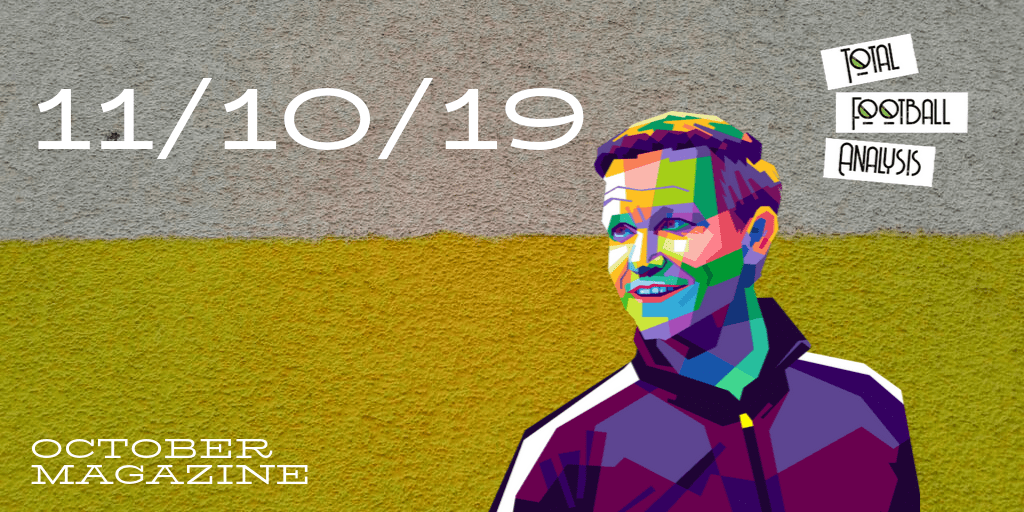
If you love tactical analysis, then you’ll love the digital magazines from totalfootballanalysis.com – a guaranteed 100+ pages of pure tactical analysis covering topics from the Premier League, Serie A, La Liga, Bundesliga and many, many more. Buy your copy of the October issue for just ₤4.99 here





Comments